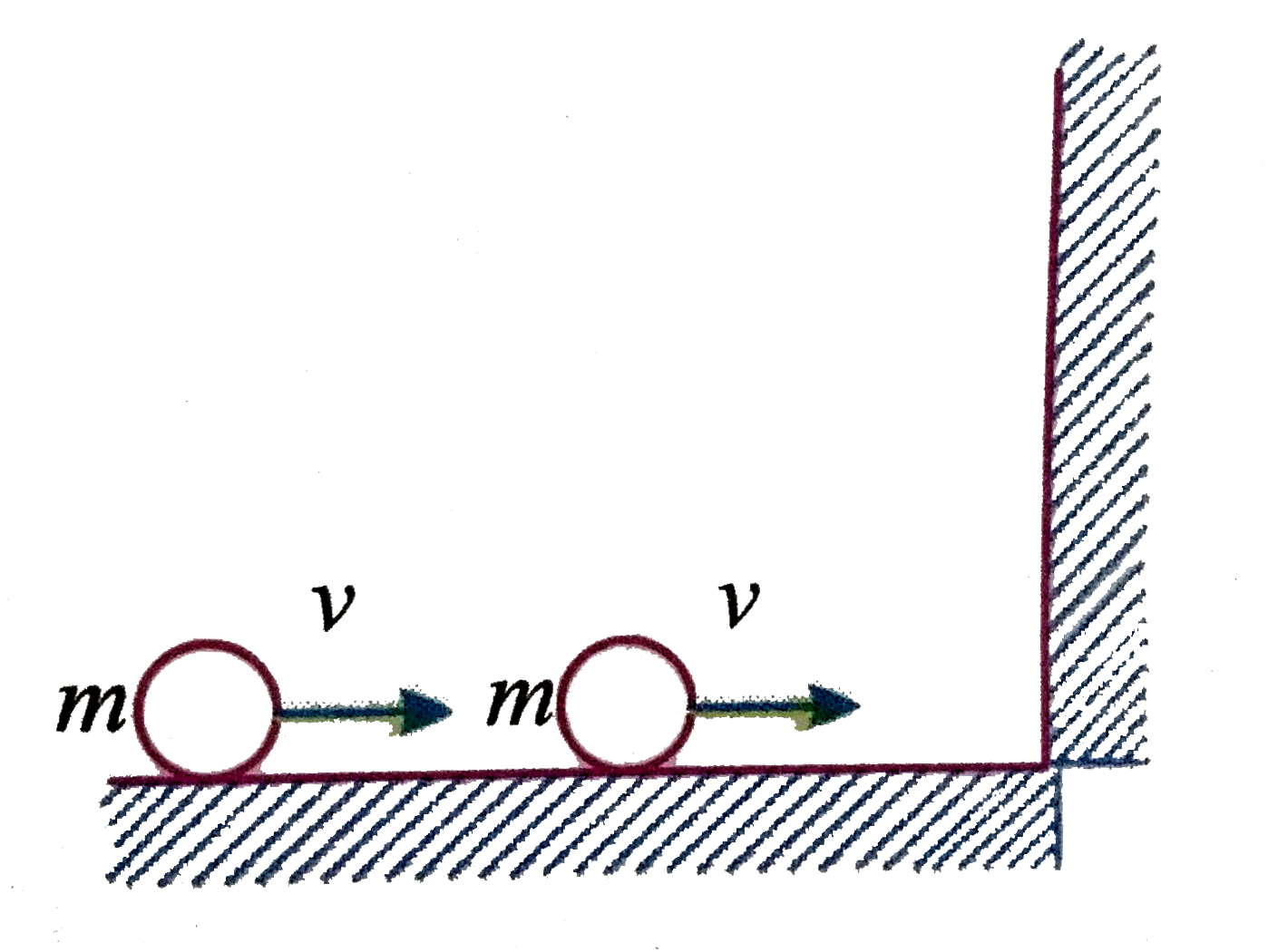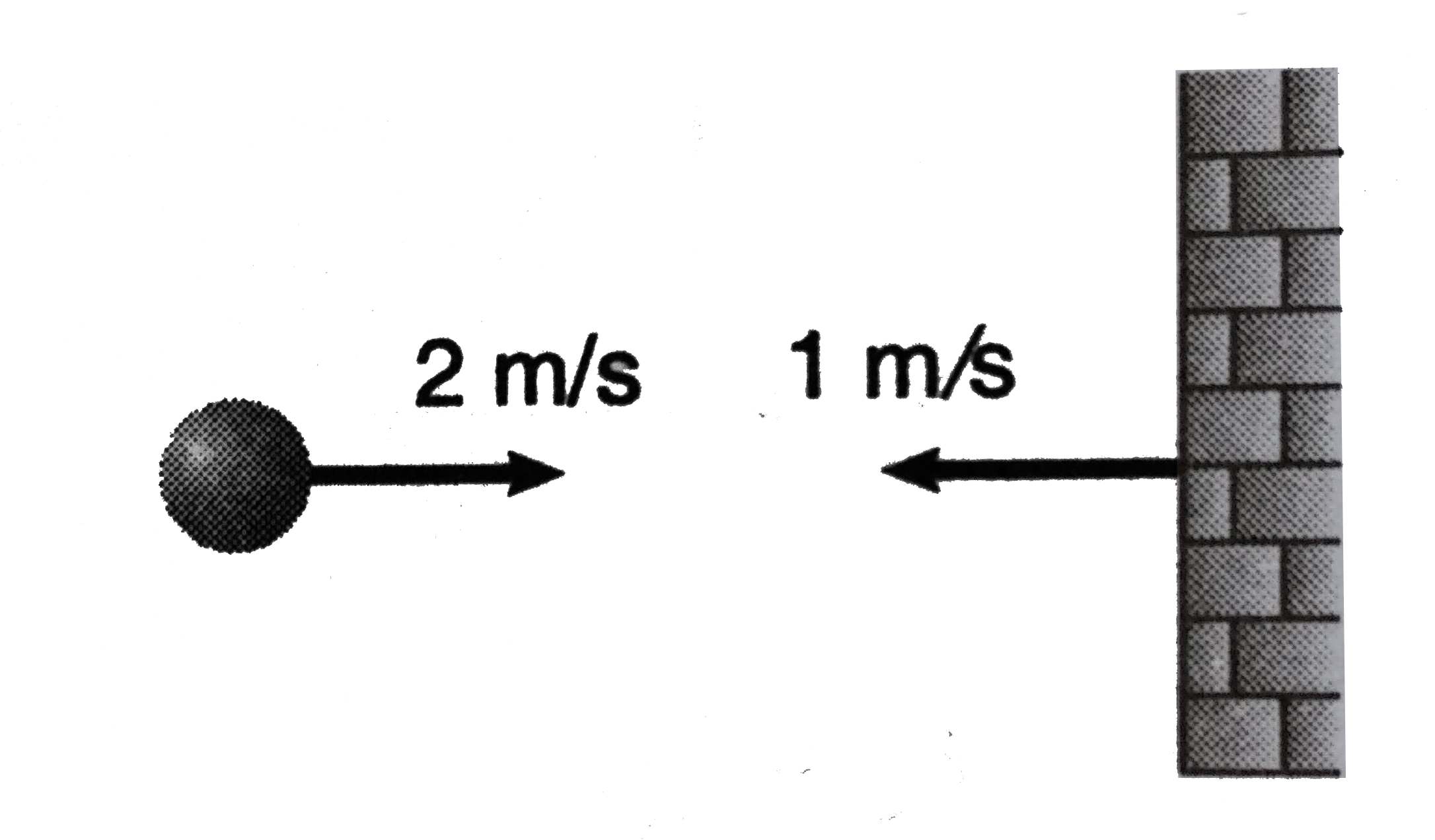The two balls shown in figure are identical the first ball is moving at a speed v towards right and the second staying at rest. The wall at the extreme right is fixed. Assume all collisions to be elastic. Show that the speeds of the balls remain unchanged after all the collisions have taken place.
 Solution in Tamil
Solution in Tamil
1st collision: As the balls have equal mass and make elastic collision, the velocities are interchanged.
Hence, after the first collision the ball A comes to rest andk the ball B moves towards right at a speed v.
2nd collision: The ball B moving with speed v collides with teh wall and rebounds. As teh wall is rigit and may be taken to be of infinite mass, momentum conservative gives no useful result. Velocity of seperation should be equal to the velocity of approach. Hence, teh ball rebounds at teh same speed v towards left.
3rd collision: The ball B moving towards let at the speed v again collides with the ball A kept at rest. As the masses are equal and teh collision is elastic, the velocities are interchanged. Thus, the ball B comes to rest and the ball A moves towrds let at a speed v. No further collision takes place. Thus, the speeds ofthe balls remain the same as their initial values.
Topper's Solved these Questions
- BOOK - HC VERMACHAPTER - CENTRE OF MASS, LINEAR MOMENTUM, COLLISIONEXERCISE - Question For short Answer25videos
CENTRE OF MASS, LINEAR MOMENTUM, COLLISION
- BOOK - HC VERMACHAPTER - CENTRE OF MASS, LINEAR MOMENTUM, COLLISIONEXERCISE - Objective -118videos
CENTRE OF MASS, LINEAR MOMENTUM, COLLISION
- BOOK - HC VERMACHAPTER - CENTRE OF MASS, LINEAR MOMENTUM, COLLISIONEXERCISE - Exercises64videos
CENTRE OF MASS, LINEAR MOMENTUM, COLLISION
- BOOK - HC VERMACHAPTER - CALORIMETRYEXERCISE - Exercises18videos
CALORIMETRY
- BOOK - HC VERMACHAPTER - CIRCULAR MOTIONEXERCISE - Exercises30videos
CIRCULAR MOTION
Similar Questions
Can the centre of mass of a body be at a point outside the body?
03:16View SolutionConsider the following two equations
(A).→R=1M∑imi→ri
and(B).→aCM=→FM
IN a noninertial frame01:55View SolutionThree particles of masses 1.0 kg 2.0 kg and 3.0 kg are placed at the corners A,B and C respectively of an equilateral triangle ABC of edge 1m. Locate the centre of mass of the system.
03:13View SolutionAn aluminium vessel of mass 0.5kg contains 0.2kg of water at 20∘C A block of iron of mass 0.2kgat100∘C is gently put into the water .Find the equilibrium temperature of the mixture, Specific heat capacities of aluminium , iron and water are 910Jkg−1K−1470Jkg−1K−1and4200Jkg−1K−1 respectively
01:57View SolutionFind the accelerationof the moon with respect to the eath from the following data, Distance between the earth and the moon =3.85×105 km and the time taken by the moon to complete one revolution around the earth =27.3days
09:06View SolutionA ball is moving with velocity 2m//s towards a heavy wall moving towards the ball with speed 1m//s as shown in figure. Assuming collision to be elastic, find the velocity of ball immediately after the collision.
06:44View SolutionA heavy ball moving with speed v collides with a tiny ball. The collision is elastic, then immediately after the impact, the second ball will move with a speed approximately equal to
04:29View SolutionFive balls are placed one after the other along a straight line as shown in the figure. Initially, all the balls are at rest. Then the second ball has been projected with speed v_(0) towards the third ball. Mark the correct statements, (Assume all collisions to be head-on and elastic.)
06:44View SolutionA highly elastic ball moving at a speed of 3 m//s approaches a wall moving towards it with a speed of 3 m//s . After the collision. the speed of the ball will be
02:25View SolutionA ball moving on a horizontal frictionless plane hits an identical ball at rest with a velocity of 0.5m/s. If the collision is elastic, calculate the speed imparted to the target ball, if the speed of projectile after the collision is 30cm/s. Show that the two balls will move at right angles to eachother, after the collision.
View SolutionTwo balls each of mass 'm' are moving with same velocity v on a smooth surface as shown in figure. If all collisions between the balls and balls with the wall are perfectly elastic, the possible number of collisions between the balls and wall together is
 02:53View Solution
02:53View SolutionA ball of mass m moving with speed v towards the right strikes a wall moving towards the left with speed u . Find the change in the K.E. of the ball if the collision is elastic.
01:09View SolutionTwo balls each of mass 'm' are moving with same velocity v on a smooth surface as shown in figure. If all collisions between the balls and balls with the wall are perfectly elastic, the possible number of collisions between the balls and wall together is
 02:50View Solution
02:50View SolutionA ball moving with speed u collides with an identical ball at rest. The velocities of two balls after collision are (If the collision is elastic):
06:01View SolutionA ball moving with a velocity of 6 m/s strikes an identical stationary ball. After collision each ball moves at angle of 30^@ with the original line of motion. Assuming that the collision is elastic, what are the speeds of the balls after the collision?
02:59View SolutionA ball is moving with velocity 2m/s towards a heavy wall moving towards the ball with speed 1m/s as shown in figure. Assuming collision to be elastic, find the velocity of ball immediately after the collision.
 View Solution
View Solution

